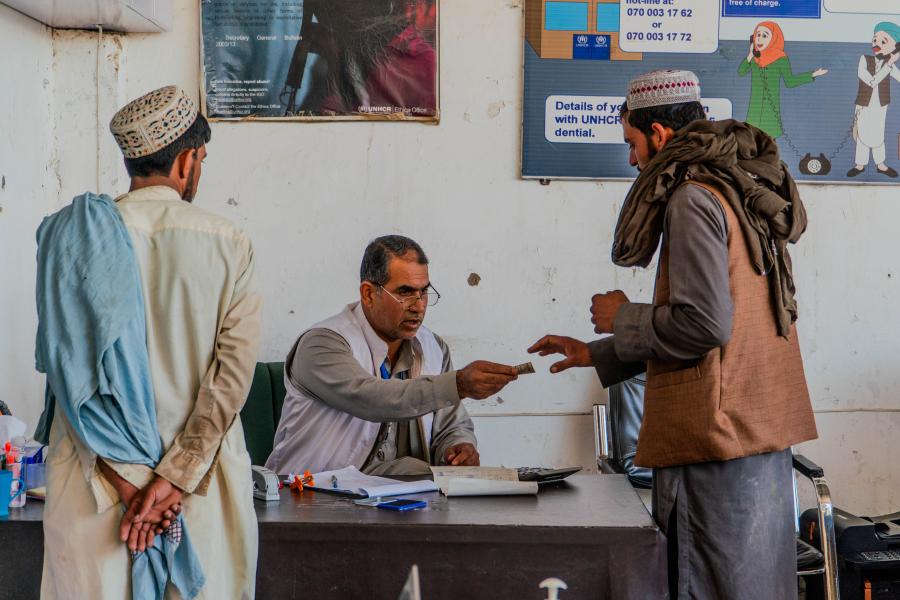Main documents
As a result of previous waves of displacement, second and third generations of Afghans are living in protracted displacement, with (the Islamic Republic of) Pakistan providing refuge to some 1.35 million registered Afghan women, children and men. The Government of Pakistan estimates a further 600,000 have sought refuge since the events of 2021 in neighbouring Afghanistan.
On 3 October 2023, (the Islamic Republic of) Pakistan’s national Apex Committee endorsed a plan to repatriate over a million foreigners without valid documents, largely Afghans. Since that time, close to 600,000 Afghans, mostly those undocumented, made the difficult decision to return as a result of pressure and fearing arrest.
At the same time, the overall situation inside Afghanistan remains challenging with significant consequences for the most vulnerable among the population, including women and girls. Some 3.2 million people are currently internally displaced by conflict, around 1.46 million IDPs have returned to their places of origin, and at least 1.6 million new arrivals since August 2021 have been witnessed in neighbouring countries. UNHCR is responding to this emergency, with needs outlined in a regional Refugee Response Plan and Afghanistan Humanitarian Needs and Response Plan. The Islamic Republics of Iran and Pakistan also host some 5.7 million Afghan refugees and Afghans in a refugee-like situation.
Explore UNHCR’s Operational Data Portal for more information and updates related to Pakistan and the Afghanistan situation.
Populations
Population types
Note: The "Stateless" category does not include stateless people who are also in other categories, to avoid double counting. The total number of stateless, across all categories, is .
NB: 2025 figures are planning figures.
Source: UNHCR Refugee Data Finder for years until 2022, UNHCR planning figures (COMPASS) otherwise.
Population by country
NB: 2025 figures are planning figures.
Source: UNHCR Refugee Data Finder for years until 2022, UNHCR planning figures (COMPASS) otherwise.
Population by origin
NB: 2025 figures are planning figures.
Source: UNHCR Refugee Data Finder for years until 2022, UNHCR planning figures (COMPASS) otherwise.
Financials
Budget and expenditure trend
Budget information for the current year is updated monthly, while budget and expenditure information for all other years are final.
Budget by pillar
Budget by objective
Note: The table presents the budget for this operation broken down at the objective level. Resource allocation at the objective level is subject to change during the course of the year as the operational situation evolves and priorities shift. The current budget, reflected in the bottom line of this table, is updated on a monthly basis and is replaced by the final budget at year-end.
Expenditure by Outcome Area
Budget by Impact Area
Source: 2023 budget as approved by the Executive Committee in October 2022.
2022 current budget as approved by the High Commissioner as of October 2022; pending presentation to the ExCom's Standing Committee.
Budget by Outcome and Enabling Areas
Source: 2023 budget as approved by the Executive Committee in October 2022.
2022 current budget as approved by the High Commissioner as of October 2022; pending presentation to the ExCom's Standing Committee.
Budget by Impact Area
Source: 2024 budget and 2023 current budget are taken from the budget document approved by UNHCR's Executive Committee in October 2023.
Budget by Impact Area
Budget information for the current year is updated monthly, while budget and expenditure information for all other years are final.
Budget by Outcome and Enabling Areas
Budget by Outcome and Enabling Areas
Budget information for the current year is updated monthly, while budget and expenditure information for all other years are final.
Budget by Impact Area
Budget by Outcome and Enabling Areas
Strategy
Impact Statements
Latest updates
The boundaries and names shown and the designations used on this map do not imply official endorsement or acceptance by the United Nations.
UNHCR GIS data is publicly accessible in the Operational Data Portal







